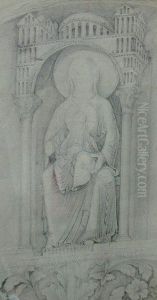Sidney H. Barnsley Paintings
Sidney Howard Barnsley was an English furniture designer and maker, architect, and a key figure in the Arts and Crafts Movement. Born on November 25, 1865, in Birmingham, England, Barnsley was the son of a brass foundry manager. He grew up in a period when industrialization was rapidly changing the English landscape and the nature of its industries, a change that the Arts and Crafts Movement later reacted against, advocating for traditional craftsmanship, quality materials, and design integrity.
Barnsley was educated at the Birmingham School of Art, where he was influenced by the Arts and Crafts philosophy of John Ruskin and William Morris. He later attended the Architectural Association in London. His brother, Ernest Barnsley, was also a notable architect and furniture designer. In 1893, Sidney, along with his brother Ernest and Ernest's brother-in-law, Alfred Hoare Powell, moved to the Cotswolds to establish a community of craftsmen at Sapperton, Gloucestershire, which became a center for the Arts and Crafts Movement.
Sidney Barnsley's work as an architect and designer was characterized by his use of traditional construction techniques and his attention to detail. He designed and constructed furniture with an emphasis on hand-crafted joinery and often incorporated inlays and other decorative elements that highlighted the natural beauty of the wood. His architectural works included private houses, alterations, and restorations, often carried out with a sensitivity that preserved the character of the original buildings while making them suitable for modern living.
Barnsley's influence extended beyond his own practice. He was a mentor to younger craftsmen and designers, and his ethos of quality and craftsmanship had a lasting impact on British design. Although not as widely known as some of his contemporaries, Barnsley's work has been recognized for its contribution to the Arts and Crafts Movement, and his pieces are still sought after by collectors.
Sidney H. Barnsley's career was cut short by his unexpected death on March 7, 1926. Despite his relatively short life, his legacy endured through his timeless designs and the continued appreciation of the Arts and Crafts ethos. Today, his work is considered an important part of the history of British design, and his pieces can be found in museums as well as private collections.
